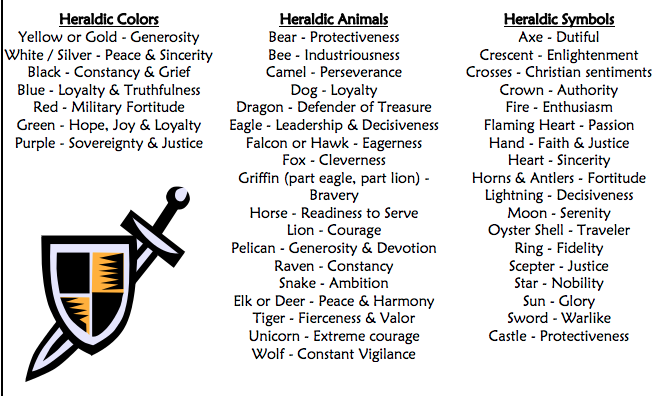
HISTORY:
Identify Yourself
How do you identify yourself to other people? On the first day of school, your teacher may ask you to place a name card on your desk so he or she can learn names more quickly. If you go to a conference or an event, you might wear a name tag. When you’re old enough, your driver’s license will become another important form of identification. What do each of these forms of identification have in common?
Medieval Identification
In Medieval Europe, the majority of people were unable to read and write. If they were presented with a name tag or a license, they wouldn’t be able to figure out what it said! Up close and personal at a banquet or a party, this was probably not a big deal…after all, you could just walk up and introduce yourself!
On the battlefield, however, it was important to know who was who. People needed to quickly distinguish friends from enemies. To solve this problem, different individuals and families developed their own symbols that let other people know who they were, without having to read the information. This use of symbols grew into a system called heraldry.
Coat of Arms
Beginning in the early 1100s, family symbols were used on a garment called a surcoat that was worn over suits of armor. Knights and warriors wore surcoats for two reasons: to help protect them from the sun (those suits of armor could get really hot!) and to protect their armor from damage. As their popularity grew, symbols were also put on other things like shields. Eventually shields became a central part of the coat of arms, a much larger visual representation of a family’s heredity.
Parts and Symbols of a Coat of Arms
Coats of arms are divided into several key parts:
-
- a shield in the center
-
- a helmet with mantling (an item that protected a knight’s neck)
-
- a crest
- a wreath that connects the crest to the helmet and mantling
The shield at the center of the coat of arms is broken into different sections as well:
-
- chief – top of the shield
-
- base – bottom of the shield
-
- sinister – left side
-
- dexter – right side
-
- pale – middle third of the shield from top to bottom
- fess – middle third of the shield from left to right
At the beginning of heraldry, families were limited in the colors they could use. White, yellow, red, and blue were very common, largely because the dyes needed to make those colors were easy to make. Other colors like black, green, and purple were much more rare and expensive. Shields featured different geometric patterns.
Popular symbols included animals, mythical beasts, or various objects that represented different meanings. For example, a bear could mean strength while a lion represented courage.
Symbols and Meanings
Who are You?
Imagine it’s your first day at a new school. You walk into a classroom filled new people…some of whom will probably be your new friends! Before you introduce yourself, you take a moment to think — what do you want these new friends to know about you? Maybe you’re an awesome dancer, or you’re a math genius. Perhaps you hold a world record for the most burritos eaten in an hour, or you can sink 50 free-throws in a row. Wouldn’t it be nice if you could share all of this information without having to say a word? In Medieval Europe, individuals and families shared all sorts of information with each other using a coat of arms, or a collection of symbols that represented various aspects of their family history, social status, and beliefs.
Color Symbolism
Did you know that colors can represent the qualities or aspects of a person, place, or thing? In Medieval Europe, the colors found on a coat of arms could mean many different things. For example, the color gold represented generosity while the color silver indicated peacefulness. Blue was a sign of loyalty, while red was used to represent both warriors and martyrs. Just like today, the color black signified grief or loss. Colors like purple were largely used by royalty. This is because the dye used to make that color was rare and hard to come by…only the very rich and very powerful could afford it.
Shields
Many coats of arms feature a large shield in the center. As you probably know, shields were used as a way for knights to defend themselves. The way a shield was decorated shared a lot of information about the person carrying it. Some shields were painted to look like different animal furs. For example, a white shield with black spots was supposed to look like ermine, a very expensive fur.
Other shields featured various patterns and geometric shapes that carried different meanings. Shields that featured a large cross in the center signified faith. Shields with a stripe extending from the upper right corner to the lower left side and shields with a large X were signs of protection.
Cross and Striped Shields
Some shields featured horizontal lines that moved from left to right. Wavy lines represent water while other lines were used to represent the walls of a fortress like the example below.
Helmets
Many coats of arms feature a helmet at the top. Helmets varied from family to family based on their social status. The majority of helmets face left. Helmets that face forward symbolize royalty. The example below is a real coat of arms. As you can see, the helmet is facing to the left.
Animal Symbols
In addition to a shield and a helmet, many coats of arms include images of various animals, mythical beasts, and objects to represent qualities about a person or family. Fierce warriors chose strong animals like tigers or bears, while courageous men adopted boars or lions to represent their houses.